Fermented rhubarb is a sweet and tart concoction, that is perfect stirred into yogurt, served on ice cream, or drizzled over pancakes. The fermentation cuts the sourness without a lot of added sugar, so you can enjoy the flavor without the usual cloying sweetness.
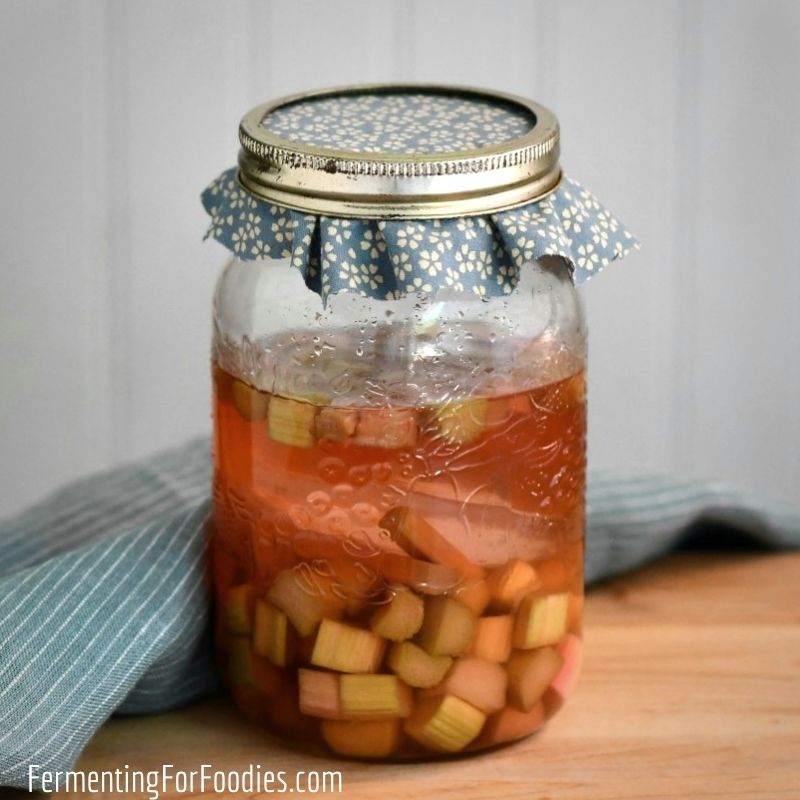
Rhubarb is the first fruit of spring. Its beautiful red color comes with a tartness that usually has rhubarb paired with super sweet desserts. In comparison, fermented rhubarb has a mild flavor that doesn’t require any additional sweetness.
In fact, I only cook and serve fermented rhubarb!
- Fermentation cuts the tartness of rhubarb while keeping its distinct flavor.
- Using a yeast-based ferment means that no additional sugar is needed. Fermented rhubarb is about as sweet as cherries or pears.
- The fermentation liquid is perfect for flavoring sparkling water or cocktails.
- It’s a zero-waste, no-cook way to preserve rhubarb. Literally, pack it in a jar and you’re done!
Types of Yeast-Based Cultures
I’ve made fermented rhubarb with ginger bug, cultured cider vinegar, and whey. All three ways worked perfectly. Basically, any yeast-based culture will work with this recipe. Not sure exactly what counts as a yeast-based culture? Here is a short list:
- Ginger bug will add a delicious gingery flavor to the rhubarb.
- Other fermented beverages include kombucha, water kefir, or jun.
- Milk kefir whey (not yogurt or cheese whey) has the yeast necessary for this ferment.
- Probably the EASIEST culture is apple cider vinegar. The trick is to make sure that you are using a live-cultured ACV. If you are buying ACV from the grocery store look for “raw”, “with mother” and “unpasteurized” on the label.
Sweet Fermented Rhubarb
Fermented rhubarb is a delicious way to preserve the first fruit of spring. It can be left whole or pureed into a pretty pink sauce. See the section above for some serving suggestions.
- Prep Time: 10 minutes
- Total Time: 10 minutes
- Yield: 1 quart jar 1x
- Category: Dessert
- Method: Fermented
- Cuisine: British
- Diet: Vegan
Ingredients
- 1/4 cup sugar
- 1 cup of filtered water, or enough to cover
- 1/4 cup of yeast-based starter culture (see above for options)
- 2 cups of rhubarb, diced (approximately 6 stalks)
- 1-inch of ginger (optional, for flavor)
Instructions
- Mix the filtered water and sugar in a glass jar. Stir until the sugar is mostly dissolved. Add in the culture.
- Dice the rhubarb into serving-sized pieces. I like the added flavor of ginger, but it’s optional. There’s no need to peel the ginger, just wash the skin and slice it in half. It will provide plenty of flavor.
- Add the rhubarb and ginger to the jar, then top with enough filtered water to keep the fruit submerged, while leaving at least 1-inch of headroom at the top of the jar.
- Leave the jar to sit out on the counter to ferment for 2-3 days. Yeast-based cultures generally do best with exposure to air, so cover the jar with a piece of cloth held in place with a rubber band or jar ring.
- After 3 days the rhubarb will have developed a mild, sweet flavor. At this point, you can either leave it whole or puree it into a sauce. It may start sparkling, however, that will mellow out after a few days in the fridge.
- Store fermented rhubarb for up to 2 months in the refrigerator, or freeze it in straight-sided mason jars
for winter eating.
Notes
- The leftover fermenting liquid can be reused for at least two more batches of rhubarb. It also makes a delicious cordial that is perfect when mixed with sparkling water.
- I generally don’t use sugar in recipes, however, this ferment relies on sucrose to feed the culture. If you are looking for a salt-brined fermented rhubarb, check out this recipe from Katie at Tracebridge Sourdough.
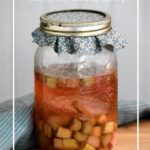

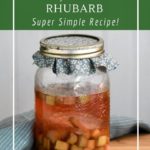
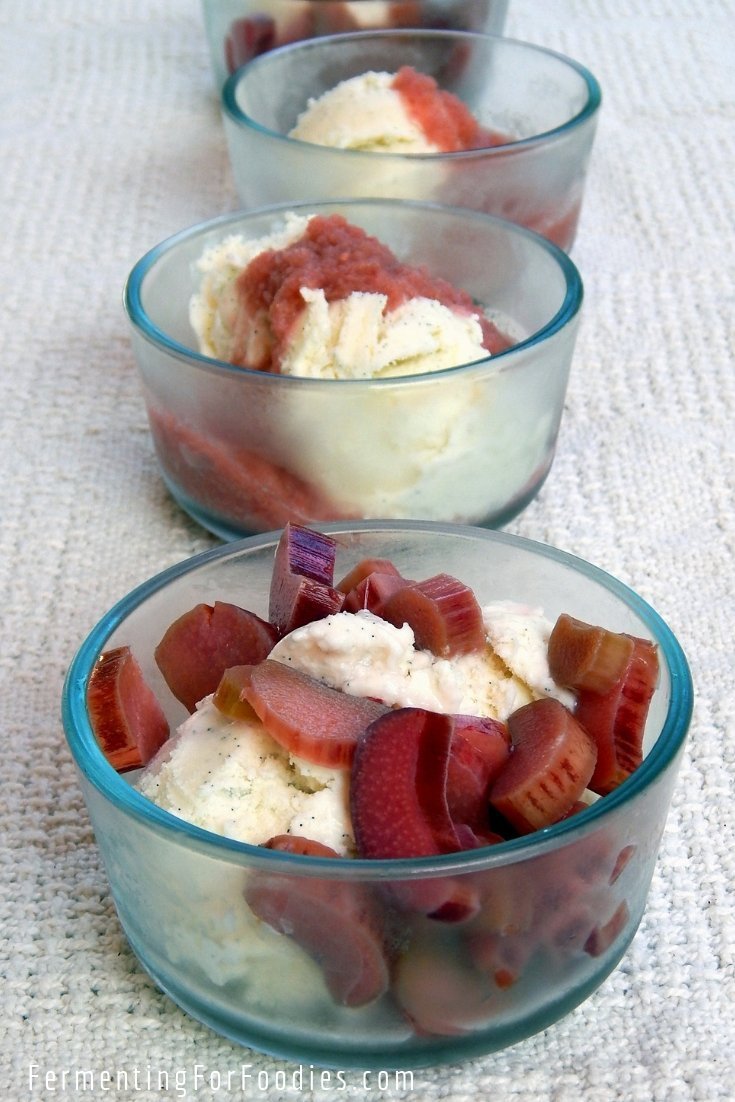
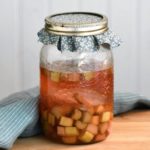
Hi Emillie. A question: would whey from homemade yogurt work as the culture or does it need to be from kefir?
I’m not sure. I designed this for a yeast based culture, but try yogurt (bacterial culture) and let me know how it goes!
Loved this so much! The best way to eat rhubarb! Thanks.
Glad you enjoyed it.
Vinegar isn’t a yeast-based culture, it supports AAB (acetic acid bacteria).
I find that live vinegar with a mother usually has enough residual yeast to ferment sugars. Only distilled vinegar has the yeasts removed. Cheers! 🙂
Do you take the rhubarb out of the liquid after it’s done fermenting or do you store it in the liquid?
I store it in the liquid… however, I typically use the liquid and the rhubarb separately. Enjoy!
This sounds so awesome!
Does freezing it cancel the probiotic goodness?
Nope! Probiotics can handle freezing. (I actually freeze some of my cultures for long-term storage). Cheers, Emillie
Hi! I didn’t add any yeast or cultures to my jar (just sugar and rhubarb expecting to make a syrup) and it started fermenting on its own. It smells yeasty and pleasant, with a light fizz. Never happened before. Advice?
It may have fermented on its own, particularly if you already make fermented foods (kombucha and sourdough both are yeasty). However, if it spontaneously fermented, then it really depends on whether you like the flavor. If there’s no mold, and the taste is pleasant, you lucked out! If it tastes like fruit juice that’s gone bad, then I recommend throwing it out. Cheers!
I just tested my recipe on Day 3. The rhubarb is crunchy and slightly sweet. I guess I’ll puree it and put on top of yogurt/kefir.
I blended the chopped fermented rhubarb in my blender, but it’s TOTALLY fibrous and inedible. I don’t have a top-end blender. How did you puree yours into a sauce?? I strained the puree, tossed the rhubarb and kept the liquid to drink.
I don’t have a great blender either. I used a stick blender and pureed after fermenting. Fermenting should help soften the rhubarb somewhat. I also typically use younger shoots, which are thin and red, and less fibrous than thick green rhubarb. Cheers!
Just double checking the metric conversion of the yeast-based starter. I will be using apple cider vinegar, but 3.8 grams is no where near 1/4 cup. If the amount is suppose to read 38 grams that would be much closer to the imperial measurement.
Hum… the metric conversion is something that is built into the recipe card app. And you’re right, that’s a huge glitch. 1/4 cup of a liquid is 60 grams… I’ll email the app developers and let them know. Thanks for pointing this out!